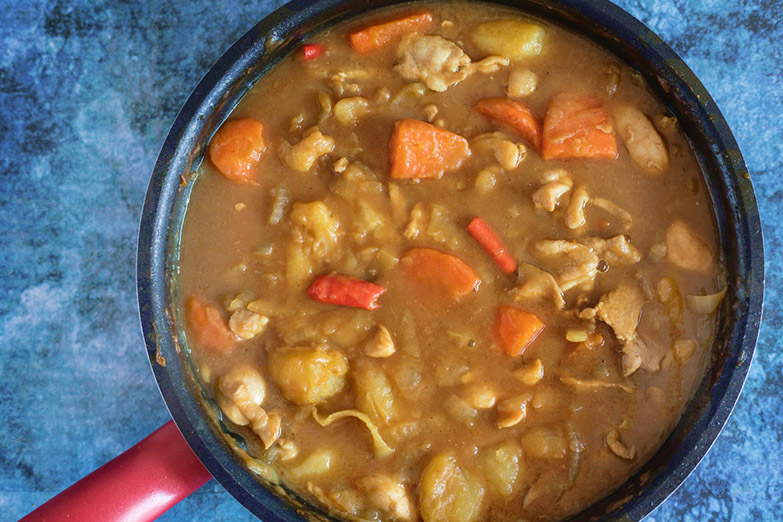Which makes sense, then, that I would want to play with a Japanese recipe for this weekend’s kitchen escapade.
But where’s the fun without adding a little touch of my own? My very Malaysian palate insists on asserting itself, albeit subtly (though readers will have to be the judge of that!).
Before we get into the weeds of homemade Japanese curry (spiced with a little kick!), what differentiates this dish from conventional curries?

Purportedly brought into Japan by the British in the late 19th century, curries back then looked more like stews made with curry powder. Today, kare raisu or “curry rice” is a popular Japanese dish served both in restaurants and at home.
Sweeter and thicker in consistency compared to other curries found in India and South-east Asia, Japanese curry leans closer to the French demi-glace with its rich and hearty texture. More toned down in terms of spice level (more on this later), even children clamour for kare raisu in Japan.
Best of all, there’s no need to make the curry base from scratch. Rather than dry frying an assortment of spices to bring out their aromas or mixing a variety of powders, most Japanese just use commercially available curry roux that are available in a block of individual cubes. (Yes, even the restaurants use these!)
There are no major fixed rules though using carrots and potatoes are considered base ingredients for a Japanese curry. Onions too, typically large white onions. If you have time, instead of dumping them straight into the pot, consider sautéing the onions first; caramelising them will add to the sweetness of the curry.

My one variation that is very Malaysian in tenor is to include a few cili padi or bird’s eye chillies. The fiery colours of these red cili padi, that pop out so beautifully on the surface of the curry, promise plenty of heat.
Sweet and (now) spicy, thick and unctuous, now that’s a Japanese curry with a surprising but welcome kick!
JAPANESE CURRY WITH CILI PADI
Besides the addition of cili padi, you may try other variations to this base recipe. These include adding apples (grated, so it dissolves in the curry) or honey for sweetness, butter or cream for extra richness, and tomatoes or yoghurt for some acidity.
One way to add umami is to douse the resultant curry with a few spurts of soy sauce or oyster sauce. To go the Japanese way, try some shoyu (sweeter than our usual soy sauce) or mix in a spoonful of miso towards the end of cooking.
Given its name – kare raisu – it goes without saying that one enjoys Japanese curry with plenty of rice. Serve it with a rice of your choice though; it doesn’t have to be white rice or the specific short-grain Japanese white rice.
I’ve enjoyed this Japanese curry with long-grain basmati rice, brown rice and purple-hued Thai riceberry. Each adds its own particular dimension to your enjoyment of the curry. What is sure is that you’ll ask for seconds or even thirds!
Ingredients
1 tablespoon olive oil
600-700g pork loin, sliced
1 tablespoon unsalted butter
2 large onions, sliced
1 litre water or chicken stock
2 carrots, peeled and diced
2-3 large potatoes, peeled and cubed
5-6 cili padi, use whole or break into halves
1 package Japanese curry roux
1 tablespoon soy sauce
2 teaspoons miso paste
Freshly ground black pepper
Salt (optional)


Method
Place a large pot over medium heat. Add the olive oil. Once the surface of the oil shimmers, add the pork loin.
Allow the meat to get some colour, about 5 minutes. The pork doesn’t have to be fully cooked here; we only want it to brown slightly to get more flavour.
Next add the butter and onions to the pot. Sweat the onions for about 5 minutes until they become slightly translucent. At this point, the meat will also no longer be pink or raw.
Add the water or chicken stock to the pot. Stir the pork and onions so that any bits sticking to the bottom of the pot is mixed in with the liquid. Now you may add the carrots, potatoes and cili padi.
Simmer over low heat for 15 minutes, stirring occasionally and skimming the scum that rises to the surface of the stew when it comes to a boil.

Cook until the carrots and potatoes have softened. Lower the heat and add the curry roux, soy sauce and miso paste. Stir briskly until these ingredients are well incorporated.
Continue to simmer until the curry has thickened; this usually takes about 5 minutes depending on the amount of starch the potatoes have released. Turn off the heat and stir in some freshly ground black pepper. Taste and season further with salt, if required.
Serve the Japanese curry with steamed rice of your choice.
For more Weekend Kitchen and other slice-of-life stories, visit lifeforbeginners.com.






















